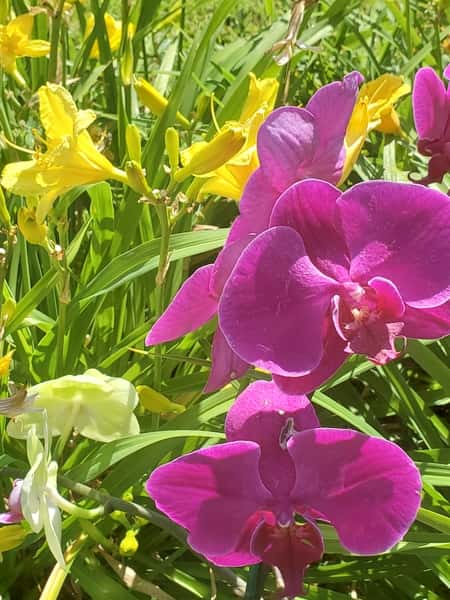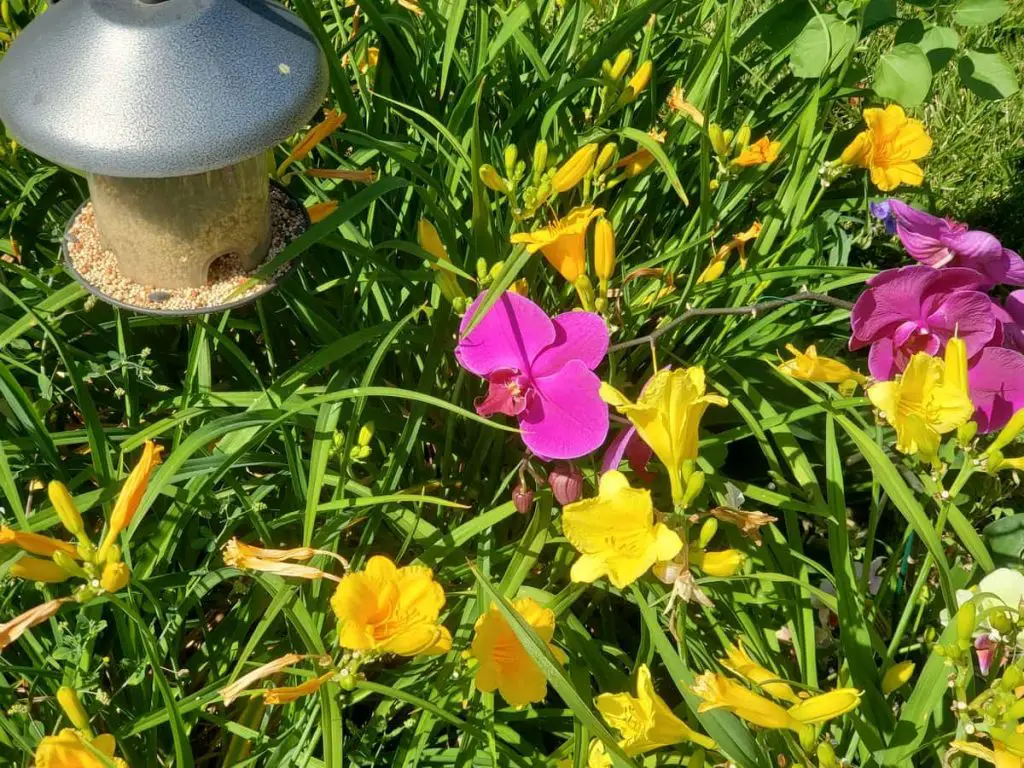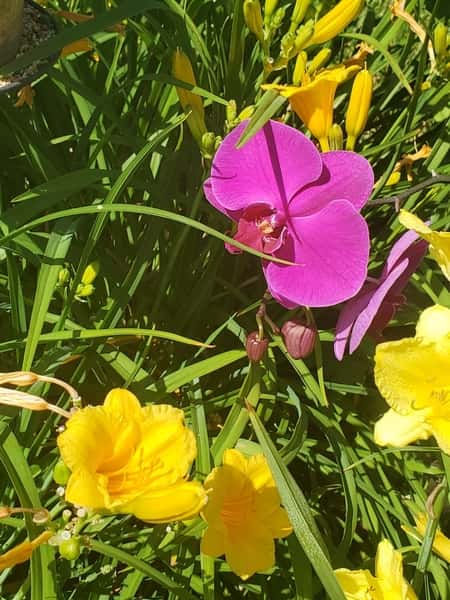Even though I’m an indoor orchid grower and my orchid collection is limited to my home office, every once in blue moon, I get tempted to grow my orchids outdoors—always killing them. When I lived in Brazil and also in Zimbabwe, the temperatures, sunlight, and humidity were perfect for keeping orchids outside all year round, and I didn’t have any problems with their care. I hardly watered my orchids since handled that.

Phalaenopsis Orchid Grown Outside
When I moved back to Kansas, where the climate gets both extreme sides of the cold and the hot, it’s really hard to grow orchids outside. This doesn’t mean it can’t be done, and in this guide, you’ll learn how.
This picture was taken when I had tried to grow my Phalaenopsis Orchid outside. The surrounding day-lilies protected the orchid leaves from the direct sun, which only was in the early morning. Kansas temperatures never let me keep my orchids outside for very long.
Can Phalaenopsis orchids be planted outside? Phalaenopsis Orchids can grow outside year-round if you live in a hardiness zone of 10 to 12 and the daytime temperatures do not rise above 85 F (29.4° C) or go below 60 F (15.5° C). Otherwise, Phalaenopsis orchids can grow outside during spring and autumn, needing to be brought inside during extreme temperatures of winter and summer.
In the continental USA, growing Phalaenopsis orchids outside year-round is harder to achieve, except if you live on the southern tip of Florida. You can verify the map below to check out your hardiness zone. In the zones from 10 to 12 is where Phalaenopsis will thrive outdoors year-round.


If you decide to cultivate your Phalaenopsis orchid outside during spring and summer, there will be several extra care tips you’ll need to observe. These items include filtering the sunlight, humidity levels, proper watering, avoidance or protection against pests and insects (including squirrels and other animals), where to keep them, and when to bring them inside.
If you observe these things, you can grow your Phalaenopsis orchids outside during spring and summer, and bring them inside when these specific conditions are no longer being met.
Let’s look at them one by one.
Note: This guide is specific for Phalaenopsis orchids grown outside. Other orchids are more suitable for outdoors, like a Cymbidium. Cymbidiums practically beg you to grow them outdoors, as they are part terrestrial and appreciate a larger airflow and sunlight.
If you have a Phalaenopsis, then the information below is for you. If not, please search for growing conditions and care guides for each a specific orchid that you own since all will be slightly (or even drastically) different.
Where to place Phalaenopsis Orchids Outside
The first consideration when bringing an indoor Phalaenopsis outside is the location, but should only be done after reading the entire article so you can take into consideration several underlying factors that I’ll mention later on.
Where is this orchid going to stay?
How much sun will it get?
Does it have access to an easy source of humidity?
Can household pets knock it over?
How will you water it?
How much heat does it get?
Once you can answer all these questions, then you’ll have the perfect location for your Phalaenopsis orchid outside, with best chances that it won’t experience bud blast or halt it’s growth cycle.
The Best Outside Temperatures for Phalaenopsis Orchids
When spring starts to come around, and the first tulips start to sprout from the ground, disrupting the layer of snow that powders the landscape, you can start to prepare your Phalaenopsis orchid to go outside.
This is my favorite time of the year because it means I survived another year of winter blues… Anyway, don’t take you Phalaenopsis outside quite yet, since there will still be unstable days in terms of temperature during the next month. I made the mistake of taking my orchids outside during the late part of March, and Kansas had one unexpected frost later that month.
I lost a whole bunch of plants, including ferns and peace lilies.
They never recuperated after that one night. This one particular event scalded me for life, and now I don’t take my orchid outside—ever.
So this guide is an attempt to save you from my mistakes. Don’t do what I did. 😊

When is the best time to take Phalaenopsis orchids outside? As soon as temperatures are consistently above 60° F (15.5° C) at night and don’t fall below that, your Phalaenopsis is ready to be taken outside. It can stay outside until the midday temperatures reach 85° F (29.4° C) , but nothing above that.
If you don’t have the shadier conditions that a Phalaenopsis requires, you can try several other ideas, instead of giving up. A shade cloth will help filter out the higher sun levels, yet does nothing for the heat. In this sense, your orchid still can get damaged from the higher temperatures.
Many orchid growers will think that growing an orchid in shade is enough in terms of proper sunlight (which I’ll explain more below), but forget that the high temperatures that don’t cool down at night will also cause the orchid leaf to burn.
The Phalaenopsis leaf accumulates the heat during the day, only to release it during the night. If your orchid sits outside and the night temperatures never cool off, the leaf will wither and die.
This means you’ll be carrying your orchids in and out twice a year.
Pest and Insect Control in Phalaenopsis Grown Outside
One thing that you’ll have to be mindful of is that once your orchids are no longer in the protection of your living room window sill, or home office, like mine are, they will be exposed to new critters.
Snails, spider mites, ants, slugs, thrips, aphids, and all kinds of pests and insects will have a fresh new medium and tender plant cells to chew on once your Phalaenopsis is outside.
There are several home remedies you can use to keep the insects away. Be sure to check out what is already in your outdoor garden and treat that first, before taking your orchids outside.
Tip: If you want good ideas for pesticides, both store bought and home remedies, this article has a list of good pesticides/insecticides. Indoor orchids will be more vulnerable since they haven’t had the protection built up from being outside and will be a target for bugs and pests.
Orchid pests are not the only living creatures that can harm your Phalaenopsis orchids when outside. Even though it’s an obvious statement, many of us don’t think about squirrels, cats, dogs, and even birds when it comes to cultivating Phalaenopsis orchids outside.
Max, my beloved rescue dog, is my “worst” problem since he is humongous (he’s a great Pyrenees) and quite clumsy. He’s also the best solution to my life, so I can’t complain…
Max used to knock over orchid pots left and right.
Even when I’m working inside, he now learned that he has to come into the office and sit under my chair, not even getting close to my plant stand. You can see a picture of him in this article, where I talk about orchid potting medium being potentially toxic to dogs, but not orchid leaves or blossoms themselves.
Anyway, back to keeping Phalaenopsis orchids outside…
Make sure you keep them in a place that cats won’t get into them too. For some reason, cats also like to chew on orchid leaves and knock the pots on the floor, just because they can. 🐕
A hanging basket is also another option, that does free up easy access for insects, household pets, and wild creatures, like squirrels.
Sunburn is the greatest harm in keeping Phalaenopsis Orchids Outside
When you’ve had your orchids inside, either under grow lights, as I do, or on an east-facing window sill, when you take them outside, they won’t have that extra protection from the sun. You need to keep the same orientation of sunlight outdoors that you had them when the Phalaenopsis orchids were inside, making sure they only get morning sun or very light evening sun, when neither is too hot.
Direct sunlight will sunburn the leaves, even if it is for only two hours. One hour a day is better.
Try to maintain the same growing conditions if at all possible. Orchids, like many people, don’t like change and thrive if they are set in one place for life. Too much change all at once and during various times during the year cause mid-life crisis over and over in an orchid.
Ok, that’s far reached, but it’s the only way I know how to explain it. Yet, if you want a more scientific explanation, the reason is that orchids will attach to tree nooks and bark and never move from there until they die (which could be 150 years if given the right growing conditions).
Yet we force them into pots and move them in spring and summer, first to morning sun from an east window, then to outside-sun on a south porch…
Since Phalaenopsis orchids are slow growers, constant change stunts their health. Constant adaptation and monthly changes in place, location, lighting, watering, fertilizing…all this takes time to get used to.
Even if you change a potting medium, let’s say from bark to sphagnum moss, that change must be left for two years before you can properly evaluate what the orchid thinks of it.
Many growers try a medium, think it’s not working, and change it in a couple of months—worse—weeks. This strains the orchid in ways that are inexplicable. This is another reason I’m against taking Phalaenopsis orchids outside.
The more you can leave them alone, the better Phalaenopsis will grow.
If you still want to take a Phalaenopsis orchid outside, choose a place that gets filtered sun. Fixing the entire pot to a tree is a great solution since it will get extra nutrients from the overhead tree, as it would in nature.
You can tie it to the tree, pot and all, but don’t just choose any side or any tree. In this article, I explain how to mount the orchid on a tree, but what I want you to focus on is what side of the tree to choose. That article explains it really well, so I won’t repeat myself in this one.
Make sure that the sun doesn’t reach the leaves and that in the hottest part of the day, it is in full shade. That is the most important thing to observe when growing Phalaenopsis orchids outside.
Watering Phalaenopsis Orchids When Grown Outside
By now, you’ve probably adhered to a watering schedule and know when to water and when to hold back. Don’t change your watering schedule after you move your orchids outside. Orchids are creatures of habit and do not like change.

Phalaenopsis Planted Outside near Day-Lilies
Yet there is one thing that you will have to observe. If your orchid is not under a covered roof, you’ll have to account for that extra rainwater and morning dew.
These are simple notes but are SO OVERLOOKED when placing orchids outside. Sometimes we place a Phalaenopsis orchid outside and adhere to the same watering schedule as inside, yet forget that they will get extra rainwater, but will also dry out faster.
Outside, the wind will dry out the Phalaenopsis roots faster than inside orchids in pots.
If your orchid is under roofing of some sort, like a porch, you’ll need to add a little more water and maybe decrease the days you refrain from watering by one.
Don’t Stop Learning!
If you want to be included in more information and get a 14-page fertilization guide, please sign up for my newsletter. I don’t spam, but send emails out bi-monthly with some curious topics of interest. If you want more information, click here to go to a specific page on this website where I explain it more in detail.

Also, if you are looking for an orchid journal to keep your notes specifically about orchid care, check out my 2 solutions for that on this page. If note-keeping isn’t your thing, then there is a free excel spreadsheet that you can download. Click here for more information on how to do that.
If you subscribe to my newsletter, I will send you a 14-page guide on the main tips of orchid fertilizer. It is downloadable and you can print it out on your computer. I designed the guide to double up as a coloring book, just to make it fun.
Humidity is the hardest to keep constant when cultivating Phalaenopsis orchids Outside
Phalaenopsis orchids like to be grown in an environment that has a relative humidity from 50 to 70%. This is usually higher than our indoor conditions, so that is why I use a humidifier. If you don’t have one, read this article, where I selected five of the best humidifiers for home use on orchids and wrote about the one I have in my home office.
Outside, that constant humidity is impossible to reach and maintain high. This is the only time I actually recommend a humidity tray. Inside they only raise the humidity about 3 to 4%, but outside, you can have a better result for the effort.
Humidity trays also serve to keep other ants, snails, and slugs out of the pot. Just add a small drop of dish detergent to the water, not enough to alter the smell or appearance. Yet, this is enough to keep tiny pests away. Cloves and lemon also do the trick.
As for growing your Phalaenopsis orchid outside, the humidity will need to be raised. If you can keep them by an outdoor pond, or next to a watering hose, and always water the grass around them, this will raise the humidity for a little while.
Misting is another way to raise humidity for outside Phalaenopsis orchids. It will have to be done constantly, and contrary to indoor advice, you can mist an orchid that is outside during evening hours. This does help bring the temperature down also, preventing damage from heat.
The last option is to try a raised flower bed, that is off the flower enough to get away from the pests and insects. The positive side to this option is that grouped with several other plants, the overall humidity level raises.
I hope this article has helped you in finding the right place for your Phalaenopsis orchid to get a breath of fresh air in the spring. I haven’t taken my orchids outside since that last frost and don’t plan to ever do that again, but that’s me. I’m just as happy having them right beside me when I’m home working on the computer.
Further Reading Suggestions:
Don’t just take my word for what is written here. Continue researching other articles about Phalaenopsis Orchid Care Outdoors, because everyone has a different point of view and unique techniques that work for them. Here are a few other articles from other websites if you’d like to continue your research on planting Phalaenopsis outside:
-“Growing Orchids Outdoors ” written by The American Orchid Association, talks about several tips on growing orchids outside. They also provide a list of orchids that will grow better outside than a Phalaenopsis will.
” written by The American Orchid Association, talks about several tips on growing orchids outside. They also provide a list of orchids that will grow better outside than a Phalaenopsis will.
-“Gardening: What you should know about growing orchids in Southern California ” written by Joshua Siskin, published on The Orange County Register talks about growing orchids outside in Southern California. The article is extremely well-written and worth a read.
” written by Joshua Siskin, published on The Orange County Register talks about growing orchids outside in Southern California. The article is extremely well-written and worth a read.
-“Orchids: A View of Our Tropical Missouri “ written by Gladys J. Richter, published on Missouri Department of Conservation talks about the native orchids that grow in Missouri. This is an interesting article because we tend to think that orchids only grow in subtropical and tropical rain-forests, yet here they are blossoming in our backyard.
“ written by Gladys J. Richter, published on Missouri Department of Conservation talks about the native orchids that grow in Missouri. This is an interesting article because we tend to think that orchids only grow in subtropical and tropical rain-forests, yet here they are blossoming in our backyard.
Happy Cultivating!


I have a ?
My store bought phil. Orchid stopped flowering. I cut the stem I node above the stem. The TIP of stem ( the 1 node below the
Top of stem I cut) turned very dry & brown?
I have been fertilizing 1 / wk.. I am starting to get 1 new green leaf
Is it normal for tip of stem to dry up
Why did the tip of Phil. Orchid stem dry out
Only @ tip of stem test of stem is green.
I cut stem just 1 node above the orchid plant.
I am starting to develop a green leaf